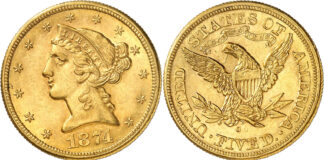
It has been a while since we published the second episode of this brief economic and monetary history of the USA. Back then, we discussed the United States’ rise to global power. Of course, this also had an impact on the economy.
Boom
With the beginning of the new century, the American economy boomed again. It was a golden age for large sections of the population – at least for the middle and upper classes of the industrial nations. In France, this period is called the Belle Époque.
In 1908, automobile manufacturer Henry Ford (*1863, †1947) presented his Model T in Detroit – the target groups were broad sections of the population, such as the farming families of the Midwest. In that first year Ford sold 6000 models at a price of 850 dollars each; less than ten years later, in 1916, the number of Ford T’s sold amounted to 577,000 units, each of which still cost 360 dollars. In that year, a Ford worker earned $5 on an eight-hour day – about as much as he had to pay for a pair of good shoes or trousers.
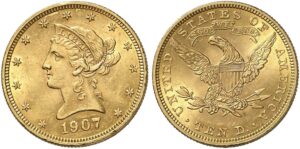
It was during this golden age that the most beautiful American coins were minted. Most important were the two large American gold coins, the eagle and the double eagle. Both coins were redesigned around 1906 by the famous American sculptor Augustus Saint-Gaudens (*1848, †1907).
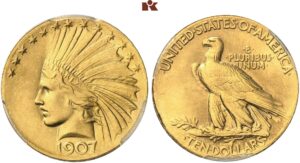
On the eagle, the crown of Miss Liberty is replaced with Native American feather ornaments. The lettering “LIBERTY” decorates the headband.

On the new double eagle of 20 dollars, Liberty can be seen in full size and with fluttering hair. In her right hand she carries the freedom torch in front of her, in her left she holds an olive branch as a symbol of peace. The sun rises brightly in the background, and the Capitol, the American Parliament, is also visible in the lower left. 46 stars – one for each state at the time – are surrounding Liberty. On the reverse of the coin, the eagle, also in front of the rising sun, soars in breath-taking flight.
Eagles and double eagles were minted in their new designs until the fateful year of 1933, when President Franklin D. Roosevelt stopped the production of gold coins due to the global economic crisis. From then on, all banks in the country were no longer allowed to issue gold or coins minted from gold. Private individuals were forbidden to possess gold, gold coins and gold certificates – a ban that was not lifted until the 1970s.
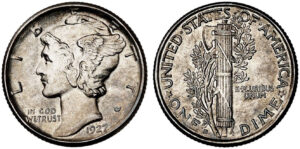
The other outstanding coin of this epoch is to be found at the other end of the monetary spectrum – in contrast to the valuable gold coins it is the small dime, the 10 cents piece. For one dime you could get a large loaf of bread in New York during 1916.
The new dime, of course, depicts Liberty on the obverse, but this time the lady wears a winged helmet, the trademark of the Roman god of fortune, Mercury. The reverse shows a fasces bundle, a bundle of the Lictors that was already known by the Romans. Its symbolism: Every single one of the bars breaks easily; but together they are strong, especially when clustered around a central official, as represented by the axe. The olive branch in turn is a symbol of peace. At a time when wars were raging in other countries, the symbolism of such coin designs should not be underestimated. In 1916, a whole series of new coins was put into circulation; not only the dime, but also the half and quarter dollar received a new image. Together with the eagle and the double eagle, these coins represented a new artistic era whose roots date back to the minting art of antiquity. Thus the new coins departed from the previous statics and, in contrast to their predecessors from the 19th century, were bursting with vitality and naturalism.
The Great Depression
During the 1920s, the USA experienced a unique boom. Between 1919 and 1929, industrial production almost doubled. In 1929, five million cars were built in Detroit. New highways, skyscrapers, housing estates in the suburbs, power plants – all of this testified to the huge wave of growth that the USA experienced. Unfortunately, unemployment did so as well since the increase in productivity was due to the use of machinery and not due to the use of labour.
The American economic growth was reflected in steadily rising share prices. Many Americans invested their savings in securities in the blind confidence that stock market prices only rise and never fall, that one can only win and not lose by investing in stocks. The great demand was driving stock prices even higher.
In 1929, there was a massive slump in prices – those who owned stocks were shocked. People began faith healing the market: politicians, respected industrialists, bankers – all tried to spread optimism and point out the healthy foundations of the market. There was a constant up and down with new waves of sales until the end of October, until Black Thursday, when the stock market price dropped to an all-time low. Prices did not stop falling until November 13. The total losses of all American stock exchanges amounted to around 50 billion dollars.
The country slipped into recession; the number of unemployed people in the USA had risen to 15 million by 1932. The crisis affected the entire global economy. In Germany, 40 percent of all people of working age were unemployed in 1932. Without the events that occurred at Wall Street and their disastrous worldwide economic consequences, Hitler would probably not have come to power so easily.
First the Economic Crisis, Then the Currency Crisis
The global economic crisis of 1929 led to the currency crisis: From 1929 to 1932, industrial production in the USA fell by almost 40 percent, with unemployment rising accordingly – in 1933 around a quarter of the American population was unemployed. In order to help the economy recover, President Roosevelt saw only one way out: controlled monetary inflation.
In 1933, the gold standard was abolished and in the following weeks the dollar lost 40 percent of its value in relation to gold. This devaluation led to an increased competitiveness of exports, and interest rates fell. The population’s propensity to invest and consume started growing and the economy slowly started to recover.
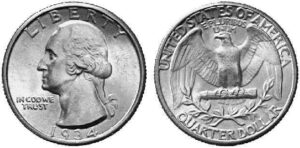
America suffered severely from the Great Depression, as the economic crisis is called in the USA. However, in 1932, the 200th birthday of George Washington was to be celebrated. The American Treasury wanted to pay due tribute to this occasion – after all, Washington had been the first President of the United States (1789–1797) and as such played a significant role in the creation of the American monetary system. Thus, in 1932, the first quarter dollars with the image of Washington were put into circulation.
The Second World War
It was the perfect surprise attack when the first Japanese bombs fell onto Pearl Harbour on December 7, 1941 at 7.51 a.m. – the US troops stationed there were not prepared for an attack. In the following two hours, Japanese fighter planes demolished the enormous American naval base: Already in the first hours of the war, the USA lost a large part of its Pacific fleet. On the following day, American President Franklin D. Roosevelt (1933–1945) declared war on Japan.
Just a few hours after the attack on Pearl Harbour, Japan continued its attacks. In an unprecedented triumphal march, it occupied the entire Indo-Pacific region in the following months until it came to a halt at the gates of Australia and India in the summer of 1942. Then, the American counteroffensive began.
It was not until Japan and the USA entered the war in December 1941, that the European war became the actual world war (which officially lasted from 1939 to 1945): In the wake of the Japanese attack, Germany and Italy declared war on the USA on December 11, 1941. In the following months German troops made their way as far as to the Caucasus, the Volga and the Egyptian border. In July 1943, the British and Americans touched down in Italy, and less than a year later, on D-Day – June 6, 1944 – the Allies landed in Normandy. This was the turning point in the course of the Second World War: The German defence was not up to the allied attack, and the military liberation of the European continent from Nazi rule began.
In East Asia and in the Pacific, the fighting continued even after the end of the war in Europe following the capitulation of Germany. In order to bring the battles in Asia to a rapid end, the American President Harry S. Truman (1945–1953) – Roosevelt had died in April 1945 – decided to drop the newly developed atomic bomb on the Japanese cities of Hiroshima and Nagasaki. On August 6, 1945, the first bomb fell on Hiroshima, three days later the second one on Nagasaki. The devastation and the number of victims exceeded any human imagination. On August 10, Japan requested an armistice, and five days later the Americans ceased military operations.
A New Financial System for a New Era
The Great Depression and its global repercussions made it clear that only an international monetary system is able to secure a stable world economic order. Thus, in 1944 in the American small town of Bretton Woods, the United Nations decided to establish the International Monetary Fund, the World Bank and a system of fixed exchange rates.
The basis of the system is therefore based on fixed relations between the currencies, with the US dollar determined as the anchor currency. This means that the exchange rates of the other member states must not deviate by more than one percent from the dollar exchange rate.
However, it was not easy to implement the Bretton Woods system after the war. Towards the end of the war, two thirds of the world’s gold reserves were located in the United States, and incidentally the United States was the only industrialised country that still had a functioning export sector – which meant that many goods would flow out of the USA but only a handful into the country. With the US dollar, it was exactly the other way around and so there was an acute shortage of dollars on international financial markets. Only after the Marshall Plan came into effect in 1948, around 13 billion US dollars made their way to Western Europe, allowing rapid and sustainable economic growth.
In the next episode, you will read about the consequences of the proxy wars against the Soviet Union during the Cold War.
You can find all parts of the series here.



